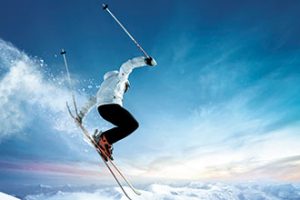 So who can’t wait to get on the slopes after watching the amazing Winter Olympians in action at Sochi? With the mornings getting darker –NOW is the time to start getting fit for our Australian ski season.
So who can’t wait to get on the slopes after watching the amazing Winter Olympians in action at Sochi? With the mornings getting darker –NOW is the time to start getting fit for our Australian ski season.
Don’t be one of the thousands who hit the slopes with enthusiasm only to hobble around for the next week or more!
To be fit to ski we need strength, flexibility, proprioception and cardiovascular fitness.
Strength exercises for a better ski position
Skiing requires a combination of endurance, eccentric control and power primarily in the quadriceps (front of the thigh) and the gluteus muscles (outer hip muscle).
Endurance is the ability of your muscles to provide tension over a long period of time and eccentric control is the ability of the muscle to lengthen slowly against gravity. Traditionally wall squats have been used to help train the quads for skiing. This though, tends to encourages you to lean back while skiing taking too much weight through your heels (and killing your shins in your boots!).
Here are two exercises to work on eccentric control and endurance that promote a better ski position
-
- Step downs off a step – In this exercise you slowly lower one heel to the floor off a step. Alignment is very important – an idea is to start by doing this exercise of some sturdy books in front of the mirror. Place your hands on your hips and as you slowly lower one heel make sure both your hips stay even and that your knee tracks over your second toe on the stance leg as it bends. Don’t let the heel actually touch the ground but just hover above before you straighten the stance knee again. High repletion is the key. Once you can do 30+ keeping good alignment then add some weight (by wearing a backpack) or add a hold half way.
- Squats – also start by doing your squats in front of a mirror – Start with your knees and feet at hip width apart and your feet facing straight ahead. As you bend your knees make sure your knees track over your second toes. Your pelvis should be in a neutral position so that your bottom doesn’t stick out too far – just like when you ski! You can find a neutral position by pushing your bottom out as far as you can and then tucking it in as much as you can then finding the spot half way between. You don’t need to go too low – just to the point where your knees are just over your toes. High repetition is the key – so just like with the squats – don’t add weight until you can do at least 30 repetitions.
Skiing also requires endurance strength in the outer hip muscles – the gluteus. The above exercise will also work the gluteus well as long as you keep your hips at an equal height. The gluteus can also be targeted by the clam exercise.
In this exercise you lay on your side with knees bend to 90degrees and feet together. Lift your top knee up, keeping your feet together and your top hip still (open at the knees). Once you can do 30 reps with ease – add weight with theraband around your knees (available from your physio).
Power is your muscles’ ability to provide a lot of tension fast – this is essential for turning while skiing. The quadriceps and the gluteus are also the main power muscles for skiing. These are trained by fast propulsive exercises such as jump lunges, split squats, hoping and skipping.
Flexibility for skiing
The good news is you don’t need to be overly flexible for skiing – though adequate hamstring (back of the leg) flexibility will certainly help prevent injury (especially from falls!) and will also help reduce load on your lower back. You also need to have adequate calf flexibility to enable you to adapt a comfortable squat position.
Proprioception helps to reduce injury in skiing
Proprioception refers to the ability of your joints to recognise where they are at any particular time. Training proprioception is helpful in reducing injury because it can act as an early warning signal that you are slightly out of alignment – hopefully in time for your body to self-correct before you fall! You can train proprioception by working on your balance. Practice standing on one leg while you do other things such as cleaning your teeth or doing the washing up. Have your knee slightly bent not locked straight.
Cardiovascular fitness helps your skiing performance
Cardiovascular fitness refers to how effective your body is at supplying and using oxygen while you exercise. You need to do whole body exercise that elevates your heart rate to train for cardiovascular fitness. Because it also involves training your muscles to better use the oxygen available to them it makes sense to use exercises that work the same muscles as skiing such as cycling and/or a step machine. You will need to do at least 30min of cardiovascular exercise 3x a week to get gains.
If you have any health problems always consult with your GP before starting any new exercise.
Remember with all exercise programs start slowly and gradually build up over time. If you have any musculoskeletal concerns or pre-existing injuries consult with your physio before starting any exercise program. We can help tailor it to your specific needs. Book online today.
